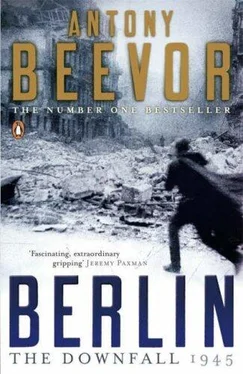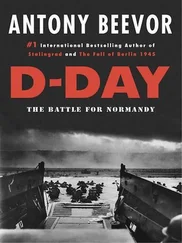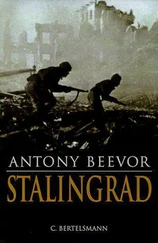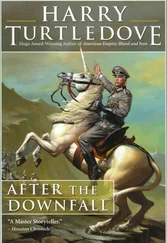Eismann hoped to be able to form a clearer picture of the situation once he reached his destination but, as he soon found, Army Group Vistula headquarters was unlike any other. In Schneidemühl he asked a military traffic controller the way, but evidently its location was a closely guarded secret. He fortunately spotted Major von Hase, whom he knew, and finally received directions.
The headquarters was established aboard Himmler’s special train, the Sonderzug Steiermark, a sleek black line of sleeping cars with anti-aircraft wagons attached. Armed SS sentries stood along the platform at regular intervals. In a ‘very elegant dining car’ Eismann found a young Untersturmführer who took him down the train to meet the Reichsführer SS and commander-in-chief.
Himmler was seated at a writing table in his saloon. When he stood up to welcome his visitor with a handshake, Eismann found that his hand was ‘soft like a woman’s’. Eismann, who had seen him only in pictures or at a distance, studied him carefully. The bespectacled Reichsführer SS was wearing not his usual black SS uniform, but field grey, presumably to emphasize his military role. He was slightly flabby, with an upper body that was too long. His receding chin and narrowed eyes gave him a ‘slightly Mongolian’ look. He led Eismann over to a larger table to study the operations map. Eismann saw that it was at least twenty-four hours out of date.
‘What have we got to close this gap and establish a new front?’ Eismann asked. He was not new to crises exacerbated, if not created, by Führer headquarters. In December 1942, he had been the officer flown into the Stalingrad encirclement on Field Marshal von Manstein’s orders to discuss the situation with General Paulus.
Himmler answered with all the thoughtless clichés of his master: ‘immediate counter-attack’, ‘smash in their flank’ and so on. His replies were devoid of any basic military knowledge. Eismann had the impression ‘that a blind man was speaking about colour’. He then asked what battle-worthy formations they had at their disposal. Himmler had no idea. He seemed unaware of the fact that the Ninth Army virtually existed in name only. Only one thing was clear. The Reichsführer SS did not appreciate direct questions in general staff style.
Army Group Vistula headquarters, it turned out, not only lacked trained staff officers, it also had no supply or transport organization and no signals detachment. The sole means of communication was the chief of staff’s telephone. And apart from the road map which Eismann had brought on his journey from Berlin, the headquarters possessed no more than one map. Even those general staff officers who had experienced earlier disasters still found it hard to fathom the degree of incompetence and irresponsibility of ‘Hitler’s Kamarilla’.
Himmler, still determined on a counter-attack, wanted to throw together odd regiments and battalions. Eismann suggested a divisional commander, who at least had a staff and communications, to organize it, but Himmler insisted on a corps commander to make it sound impressive. He chose Obergruppenführer Demmlhuber. (Army officers had given Demmlhuber the nickname of ‘Tosca’ after a well-known scent of that name which he was suspected of using.) A makeshift corps staff was assembled and the following day Demmlhuber took over. Demmlhuber, who had more experience than Himmler, was not overjoyed at the task given him. The operation, if it deserved such a name, proved a complete failure, and he became one of the very few Waffen SS generals to be dismissed. This perhaps provoked jokes among opera-lovers on the army general staff that ‘Tosca’ may have been pushed out, but at least he had not had to jump.
Another Waffen SS officer arrived to take over as chief of staff of the army group. This was Brigadeführer Lammerding, a former commander of the SS Das Reich Panzer Division. Although a respected commander, he had little staff experience and no taste for compromise. Meanwhile, the Soviet advance on Schneidemühl forced Army Group Vistula head-quarters to withdraw northwards to Falkenburg. Schneidemühl, designated a fortress by Hitler along with Poznan, was left to its fate, with eight battalions of Volkssturm, a few engineers and some fortress artillery. Hitler’s dogma, ‘Where the German soldier has once stood, he will never retreat’, remained the watchword.
A Pomeranian Volkssturm battalion on its way to Schneidemühl by train from Stolp passed Himmler’s Steiermark train. This so-called ‘battalion’ was commanded by Baron Jesko von Puttkamer, the landowner who had threatened the pot-bellied Nazi official. He and his officers, dressed in their uniforms from the First World War, had brought their old service pistols. Their men, mostly farmers and shop-keepers, had no weapons at all, only Volkssturm armbands. They were supposed to receive weapons in Schneidemühl. Suddenly, the train came under fire from Soviet tanks. The driver managed to stop and then reverse with remarkable promptness.
Once they were well away from danger, Puttkamer ordered his men out of the train. He then marched them back to Stolp through the knee-deep snow, with the strongest placed at the front to trample a route for the rest. He refused to allow them to be killed for nothing. On their return, the townspeople greeted him as a hero in the Stephansplatz outside the town hall. But Baron von Puttkamer retired to his house, sick at heart, and put away the old uniform, which had become dishonoured ‘under these Hitlers and Himmlers’.
5. The Charge to the Oder
By the fourth week in January, Berlin appeared to be in a state of ‘hysteria and disintegration’. There were two air-raid warnings a night, one at 8 and the next at 11. Refugees from the eastern territories passed on terrible accounts of the fate of those caught by the Red Army. Hungary, Germany’s last ally in the Balkans, was now siding openly with the Soviet Union and rumours of the rapid advance of Soviet tank armies led to predictions that the whole Eastern Front was disintegrating. Ordinary soldiers hoped that the enemy would shoot only officers and the SS, and workers and minor officials tried to convince themselves that the Russians would do them no harm.
The most accurate news of the situation on the Eastern Front filtered back through railway workers. They often knew how far the enemy had advanced before the general staff. More and more Germans took the risk of listening to the BBC to find out what was really happening. If denounced to the Gestapo by a neighbour, they faced a spell in a concentration camp. Yet many Hitler and Goebbels loyalists still passionately believed every word of the news according to the ‘Promi’, the Propaganda Ministerium.
Public transport was still repaired and people continued their struggle to work each day through the ruins. But more and more arranged to sleep in apartments closer to their work. A sleeping-bag had become one of the most essential items of equipment. Camp beds were also needed for relatives and friends fleeing from the east or who had been bombed out in Berlin. The well connected discussed different ways to escape the capital. Rumours of landowners shot out of hand by Soviet troops in East Prussia convinced them that the upper classes as a whole would be targets. Soviet propaganda was aimed almost as much at the eradication of ‘Junker militarism’ as at National Socialism.
Those attempting to get out had to be careful, because Goebbels had declared that leaving Berlin without permission was tantamount to desertion. First of all, they needed a travel permit, which could be obtained only with some story of essential work outside the capital. Many of those who really did have an official trip to make away from Berlin received murmured advice from envious colleagues, ‘Don’t come back. Stay there.’ Almost everyone dreamed of seeking sanctuary in a quiet corner of the countryside where farms still had food. Some even investigated the possibility of purchasing false passports, and foreign diplomats suddenly found themselves extremely popular. Members of ministries were fortunate. They were evacuated to the south over the next few weeks.
Читать дальше











